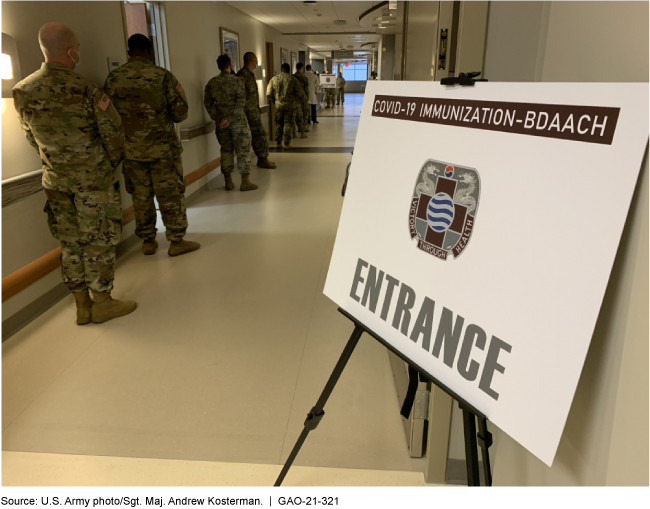COVID-19: DOD Has Focused on Strategy and Oversight to Protect Military Servicemember Health
Fast Facts
The Department of Defense received about $10.5 billion to help it respond to COVID-19. We examined DOD's strategy for protecting servicemembers as well as its research and development work on vaccines, testing, and more.
DOD's strategy seeks to balance a reduction of health risk with the need to continue operations. Among other things, it identifies mission-essential functions, prioritizes vaccine distribution, and calls for protective measures such as social distancing.
DOD has leveraged its infectious disease research and development infrastructure and investments to advance medical countermeasures that prevent, treat, and detect COVID-19.
Military servicemembers wait to receive a COVID-19 vaccine at Brian D. Allgood Army Community Hospital at U.S. Army Garrison Humphreys, South Korea on December 29, 2020.

Highlights
What GAO Found
Since January 2020, the Department of Defense (DOD) has developed a strategy to protect the health of military servicemembers from COVID-19, with a goal of minimizing risks while continuing operations. The strategy tailors protection measures to local conditions and risks to health and force readiness. GAO found that DOD's strategy applies several key considerations.
DOD Application of Key Considerations to Protect Servicemembers from COVID-19

DOD officials oversee the implementation of the department's COVID-19 health protection strategy for servicemembers through:
- Sustained leadership attention. In January 2020, the Secretary of Defense initiated COVID-19 planning and established a senior task force to oversee the response. Combatant command and installation officials continuously evaluate regional and local implementation and perform compliance checks. Notwithstanding these efforts, DOD officials stated that they expect some limited incidents of personnel not following protocols.
- Data monitoring. Senior leaders and local commanders assess data on cases, community spread, and testing, among other metrics, to inform strategy implementation and assess its effectiveness.
- Lessons learned analyses. While these analyses are ongoing as the pandemic continues, DOD has implemented mitigations to address some challenges identified, such as a new system to collect more timely and specific COVID-19 case data.
DOD has research and development projects underway to advance COVID-19 vaccines and therapeutics and improve detection methods. DOD's investments include many projects that have specific applications for servicemembers, such as pre- and postexposure prophylactic treatments to prevent the onset of the disease.
Why GAO Did This Study
The COVID-19 pandemic poses risks to the health of U.S. servicemembers. Protecting forces from COVID-19 is therefore essential to DOD's ability to defend the United States, maintain warfighting readiness, and support the whole-of-government response to the pandemic.
To help facilitate the COVID-19 pandemic response, Congress appropriated about $10.5 billion to DOD through the CARES Act. The CARES Act includes a provision for GAO to report on its ongoing monitoring and oversight related to the pandemic. GAO was also asked to examine the military health system response to COVID-19. This report examines, in regard to COVID-19, DOD's (1) strategy for protecting military servicemember health, (2) oversight of its strategy, and (3) research and development projects for vaccines, therapeutics, and testing.
GAO reviewed guidance and plans for health protection and pandemic response that comprise DOD's strategy, and evaluated alignment of the strategy with key considerations from prior GAO work on pandemic preparedness. To identify oversight efforts, GAO reviewed DOD briefings on the progress of health protection measures, and analyzed 2020 DOD data on COVID-19 cases, hospitalizations, and testing.
GAO also interviewed DOD leaders, officials from the military department medical organizations, combatant commands, and four military medical treatment facilities selected on the basis of military department and location.
For more information, contact Brenda S. Farrell at (202) 512-3604 or farrellb@gao.gov.
